- Author Miguel Ramacey [email protected].
- Public 2023-12-17 06:11.
- Last modified 2025-01-24 21:21.
There are many ancient monasteries in Russia. One of the most famous is Luzhetsky, located near Mozhaisk on the banks of the Moscow River. This most interesting Orthodox complex annually attracts hundreds of tourists and believers, most of whom consider it one of the few places in Russia that has preserved the spirit of the old pre-revolutionary Orthodox monasteries.
When and by whom was it founded?
A lot of ancient chronicles tell about how the Luzhetsky monastery in Mozhaisk developed (its photo is presented on the page). The first stones of this most interesting complex were laid in 1408. The founder of the monastery was a disciple of Sergius of Radonezh Ferapont Belozersky.
By the time of the construction of the Luzhetsky Monastery, the elder was already 70 years old. This monastery was founded at the request of Prince Andrei Mozhaisky.
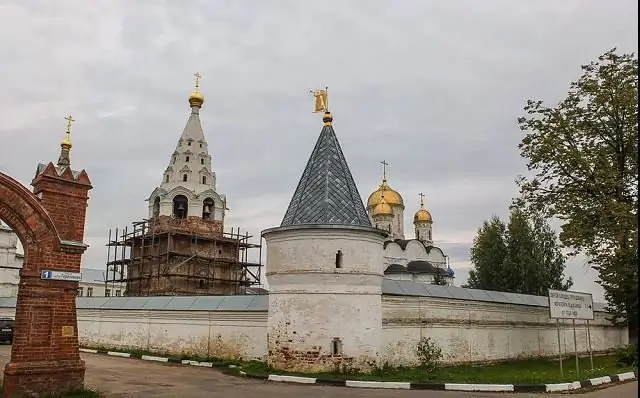
Short biography of Father Ferapont
This Orthodox saint was born near Volokolamsk in 1337. His parents were boyars. In the world, the future founder of the Luzhetsky Monastery was called Fyodor Poskochin. Inokomthe saint decided to become already in adulthood. He took the tonsure at the Moscow Simonov Monastery. He was blessed by the then abbot of the monastery, Father Fyodor, who was the nephew of Sergius of Radonezh. Presumably, the saints were tonsured in 1385.
In the Simonov Monastery of St. Ferapont became friends with another righteous reverend, Father Cyril. Together they founded a monastery on the shore of Beloozero. According to legend, the place of construction of the new monastery was indicated to Father Cyril by the Mother of God herself. The Belozersky monastery was founded by the monks in 1398. It was in this monastery that Father Ferapont spent the next ten years of his life until he was invited by Prince Andrei to found a new monastery.
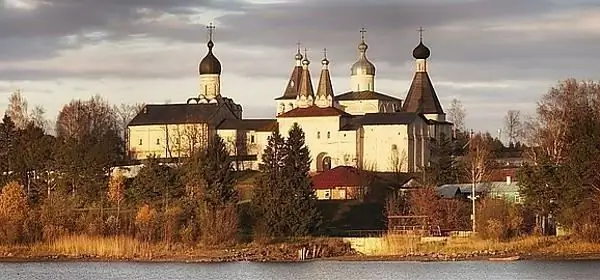
Building a monastery
Arriving in Mozhaisk, Father Ferapont blessed the place where the construction of the monastery was planned. The complex was built with the money of Prince Andrei. Many monasteries in Russia were built of wood. Stone was originally chosen for the construction of religious buildings of the Luzhetsky Monastery. The first built was the Cathedral of the Nativity of the Mother of God. At the same time, cells were erected for the future brethren.
Father Ferapont Belozersky himself was appointed the first archimandrite of the new monastery. Remained the residence of St. Luzhetsky Bogoroditsky Monastery for 18 years. Elder Ferapont died in 1426 at the age of 95. Father Ferapont was canonized in 1547. The elder was buried at the northern wall of the Cathedral of the Nativity of the Virgin. Later, a temple was built over his grave. Currently fromof this structure, only the foundation remained.
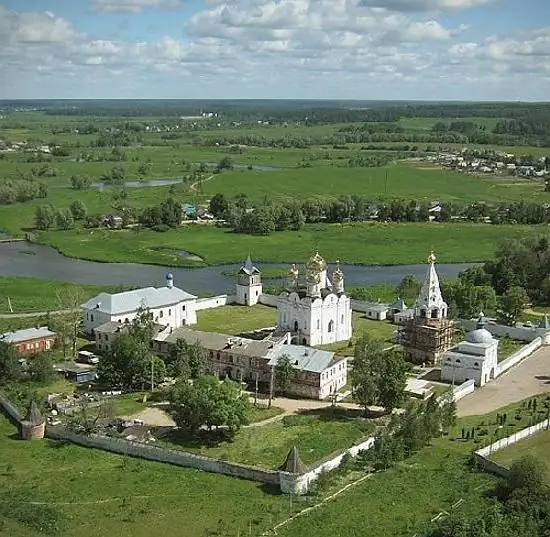
Short biography of Prince Andrei
The Russian ruler, by whose decree the Ferapontov Luzhetsky Mozhaisk Monastery was erected, was the third son of Dmitry Donskoy. He became Prince Mozhaisky in 1389. These lands were bequeathed to him at the age of seven by his dying father. In addition to Mozhaisk, his possessions included such cities as Kaluga, Iskona, Galichich and Beloozero, where Father Ferapont lived for a long time.
The idea of building a monastery came to Prince Andrei for a very simple reason. The fact is that in the vicinity of the main city of its lands there were no large monasteries dedicated to the Nativity of the Most Holy Theotokos. After the construction of the monastery, this ruler helped its archimandrite in every possible way. Prince Andrei Mozhaisky died six years after the death of his father Ferapont - in 1432.
Creating a new ensemble
Today the Luzhetsky Monastery complex (Mozhaisk) includes, of course, much more buildings than there were under Father Ferapont. The creation of the current ensemble of the monastery began in 1523 on the initiative of the then Archimandrite Father Macarius of Moscow. At the request of this priest, the temple of the Mother of God, which had stood for about a hundred years, was demolished. In its place, a large five-domed Cathedral with a gallery was built. The temple was painted by specially invited masters of the school of Dionysius. Unfortunately, only fragments of those frescoes have survived to our time.
In 1692, with the support of Patriarch Joachim, athree-tiered bell tower. The main donors of the monastery at that time were representatives of the Saveliev family. Later they were buried on the first tier of this structure. Unfortunately, their tombstones, like the frescoes in the Cathedral, have not been preserved.
What kind of buildings the Luzhetsky Monastery consisted of (photos of the modern complex presented on the page, its scale is clearly demonstrated) in the past is not known for certain. But there is a letter, according to which between 1569 and 1574 four royal children were sent to the monastery. And this means that at least 4 churches operated on the territory of the monastery.
Temple of St. Ferapont
This church was built directly above the relics of the founder of the Luzhets monastery. When exactly it was bookmarked is also unknown. Some researchers suggest that the temple could have stood on the territory of the monastery during the life of the saint. Others believe that it was built at the beginning of the 16th century. Exact references to the existence of this monastery are found only in documents from the end of the 16th century.
Luzhetsky Monastery in the Time of Troubles
During the period of the Lithuanian invasion of 1605-1619. the monastery was seriously damaged. All churches were completely destroyed. The disaster happened so serious that for another 7 years after that, services were performed only in the Cathedral. From this largest temple of the complex, as well as from all the others, the Lithuanians took out a huge amount of icon frames, sacred vessels and other valuable church utensils. Fortunately, the coffin of Father Ferapont then remained intact. The monastery was restored in subsequentyears mainly on donations.
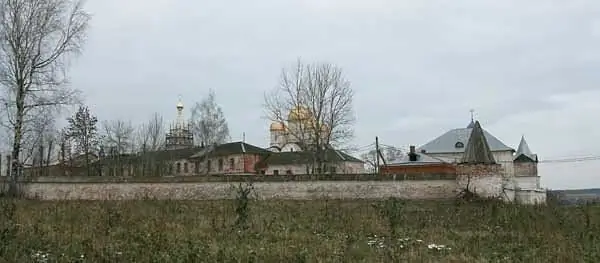
Abode under the French
Another disaster Luzhetsky monastery suffered during the war with Napoleon. The French who captured Mozhaisk placed the Westphalian corps of General Junod in the monastery. As a result, the monastery was turned into a kind of carpentry.
Like the Lithuanians, the French stole many expensive church utensils from churches and the Cathedral. However, fortunately, this time the invaders did not cause much damage to the monastery. For example, the church of St. Feraponta was completely ready for consecration within a month after returning to the brethren's monastery.
Icon of the Head of the Forerunner
In 1871, in the new aisle of the church of St. Ferapont, an iconostasis and a holy throne were arranged. The icon of the Head of the Forerunner miraculously preserved on the front side in 1812 was chosen as the main temple icon (its back side was heavily chopped). The chapel was consecrated in honor of this icon in September 1871.
In the years of Soviet power
Like all other monasteries in the country, during the years of communist rule, the Luzhetsky Monastery experienced far from the best of times. In 1929 it was closed. Part of the brethren was dispersed, the other part was repressed. Before the Second World War, a workshop for the production of medical equipment operated in the monastery. Above the necropolis, the authorities arranged garages and warehouses with viewing pits. Then for a long time the monastery was completely abandoned.
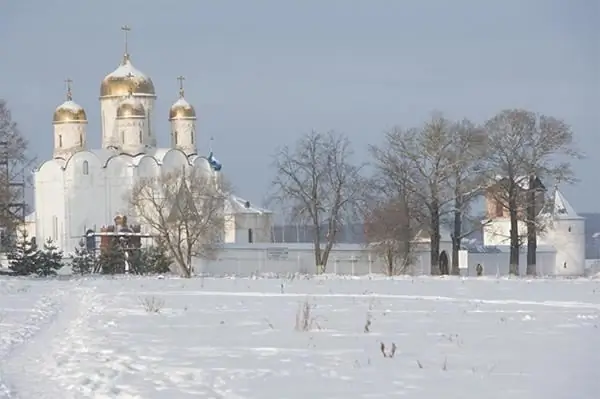
Restoration of the monastery
Transferred to Luzhetsky Churchthe monastery was in 1994. The first episcopal service in the newly opened Church of the Nativity took place on October 23. In May 1999, at the initiative of Metropolitan Yuvenaly of Kolomna and Krutitsa, the relics of St. Ferapont. Now they have been moved to the Cathedral of the Nativity of the Virgin.
In April 2015, a new bell weighing 2.5 tons was raised to the bell tower of the monastery. The opening of this religious building took place on August 9, 2015. Before that, the reconstruction of the bell tower lasted 10 months.
Features of the modern complex
To date, the Luzhetsky Ferapontov Monastery includes the following buildings:
- cells with the rectory;
- bell tower with the tomb of the Savelov family (1673-1692);
- Cathedral of the Nativity of the Blessed Virgin (1524-1547);
- foundation left from the treasurer's house (late 19th century);
- church of the introduction of the Blessed Virgin with refectories (XVI century);
- northern and southern buildings in the eastern part (late 19th early 20th c.);
- Gateway Church of the Transfiguration (1603);
- foundation of the church of St. Ferapont;
- necropolis.
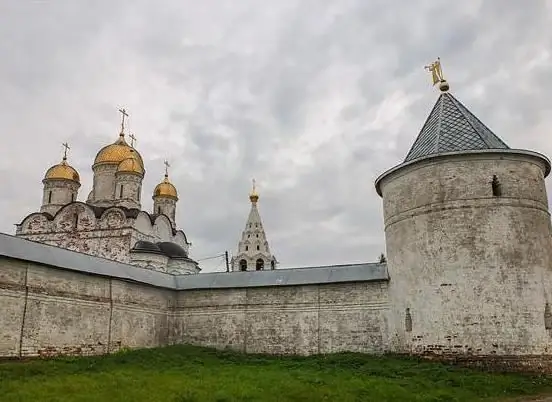
The Gateway Church of the Transfiguration, among other things, is famous for the fact that Boris Godunov himself was present at its consecration in 1603.
In addition to the structures listed above, the entrance eastern gate, erected in 1780, has also been preserved on the territory of the monastery. The Luzhetsky Monastery is surrounded by a fence with towers 1681-1684years. On the territory of the complex there are also economic gates, erected in the 90s of the XIX century. The necropolis includes several ancient tombstones with a forked cross and pagan symbols.
From the walls of the monastery offers a magnificent view of the Moscow River. Near the monastery, at its very walls, a dam was built.
Spring
Another attraction of the monastery is a well with holy water. It is not located on the territory of the monastery, but in the nearby village of Isavitsy. It is believed that this well was dug by Elder Ferapont himself.
The area around the spring is landscaped - there are benches and baths. A monument to Father Ferapont was also erected here. There is also a chapel and a church shop in the village. To get to the well, you need to stand in line. There are many people who want to draw holy water in the spring of Ferapont.
Necropolis of the monastery
Some tourists find the cemetery of the monks, located on the territory of the monastery, rather unusual. It seems that the tombstones do not belong to the graves at all. The fact is that many of them are engraved with completely non-Christian symbols: swastikas and kolovrats. The same stones lie in the backyard. They were once used as material for the construction of the monastery.
Perhaps in ancient times this place was a pagan cemetery. And in order not to go far, the first builders simply used strong tombstones for the construction of religious buildings of the new official religion. Of course, this is nothing more than a guess. However, out of nowhere, pagan symbols (and onsome stones and inscriptions in the Old Slavonic language) could not be taken, of course.
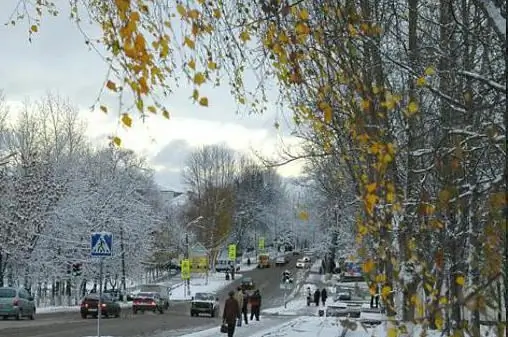
Mozhaysky Luzhetsky Ferapontov Monastery: how to get there?
By public transport from Moscow to the monastery can be reached from the Belorussky railway station. To do this, you need to take an electric train going to the Mozhaisk station, and then go by bus to the Moskva River stop.
By personal transport, you should move along the Minsk highway to Mozhaisk. Then you need to turn to the river following the signs. In total, the road from Moscow to the monastery takes no more than two hours.






